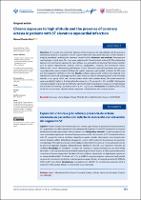Chronic exposure to high altitude and the presence of coronary ectasia in patients with ST elevation myocardial infarction
Related Resource(s)
https://apcyccv.org.pe/index.php/apccc/article/view/329Date
2023-12-13Author(s)
Chacón Díaz, Manuel Alberto
Metadata
Show full item recordAlternate title
Exposición crónica a gran altura y presencia de ectasia coronaria en pacientes con infarto de miocardio con elevación del segmento ST
Abstract
Objective. To evaluate the association between chronic exposure to high altitude and the presence of coronary ectasia (CE) in patients with ST-segment elevation myocardial infarction (STEMI) treated in a highly specialized cardiovascular reference hospital in Peru. Materials and methods. Retrospective matched case-control study. The cases were patients with CE and controls without CE. The relationship between CE and chronic exposure to high altitude was evaluated considering intervening variables such as arterial hypertension, diabetes mellitus, dyslipidemia, smoking, and hematocrit values. Patients with chronic inflammatory pathologies, chronic obstructive pulmonary disease, and previous revascularization were excluded. Multivariate logistic regression was applied to obtain the OR value and their respective confidence intervals. Results. Eighteen cases and 18 controls were studied, most of them were men with an average age of 65 years. Thirty-six percent of the population came from high altitude; in this group 76.9% had coronary ectasia of the infarct-related artery. The mean hematocrit value was slightly higher in the high-altitude native (46 ± 7% versus 42 ± 5%, p=0.094). Multivariate conditional logistic regression did not find a significant relationship between exposure to high altitude and the risk of presenting CE (OR:6.03, IC95%: 0.30-118, p=0.236). Conclusions. In patients with STEMI, we found no association between chronic exposure to high altitude and coronary ectasia. Objetivo. Evaluar la asociación entre la exposición crónica a gran altura y la presencia de ectasia coronaria (EC) en pacientes con infarto de miocardio con elevación del segmento ST (IAMCEST) tratados en un hospital de referencia de alta especialidad cardiovascular en Perú. Materiales y métodos. Estudio retrospectivo de casos y controles emparejados. Los casos fueron pacientes con EC y los controles sin EC. Se evaluó la relación entre EC y exposición crónica a la altura, teniendo en cuenta variables intervinientes como hipertensión arterial, diabetes mellitus, dislipidemia, tabaquismo y valores de hematocrito. Se excluyeron los pacientes con patologías inflamatorias crónicas, enfermedad pulmonar obstructiva crónica y revascularización previa. Se aplicó una regresión logística multivariable para obtener el valor OR y sus respectivos intervalos de confianza. Resultados. Se estudiaron 18 casos y 18 controles, la mayoría hombres con una edad media de 65 años. El 36% de la población procedía de zonas de gran altitud, de ellos, el 76,9% presentaba ectasia coronaria en la arteria responsable del infarto. El valor medio de hematocrito era ligeramente superior en los nativos de altitud (46 ± 7% frente a 42 ± 5%, p=0,094). La regresión logística condicional multivariable no encontró una relación significativa entre la exposición a gran altitud y el riesgo de presentar EC (OR:6,03, IC95%: 0,30-118, p=0,236). Conclusiones. En pacientes con IAMCEST no encontramos asociación entre la exposición crónica a gran altitud y la presencia de ectasia coronaria.






